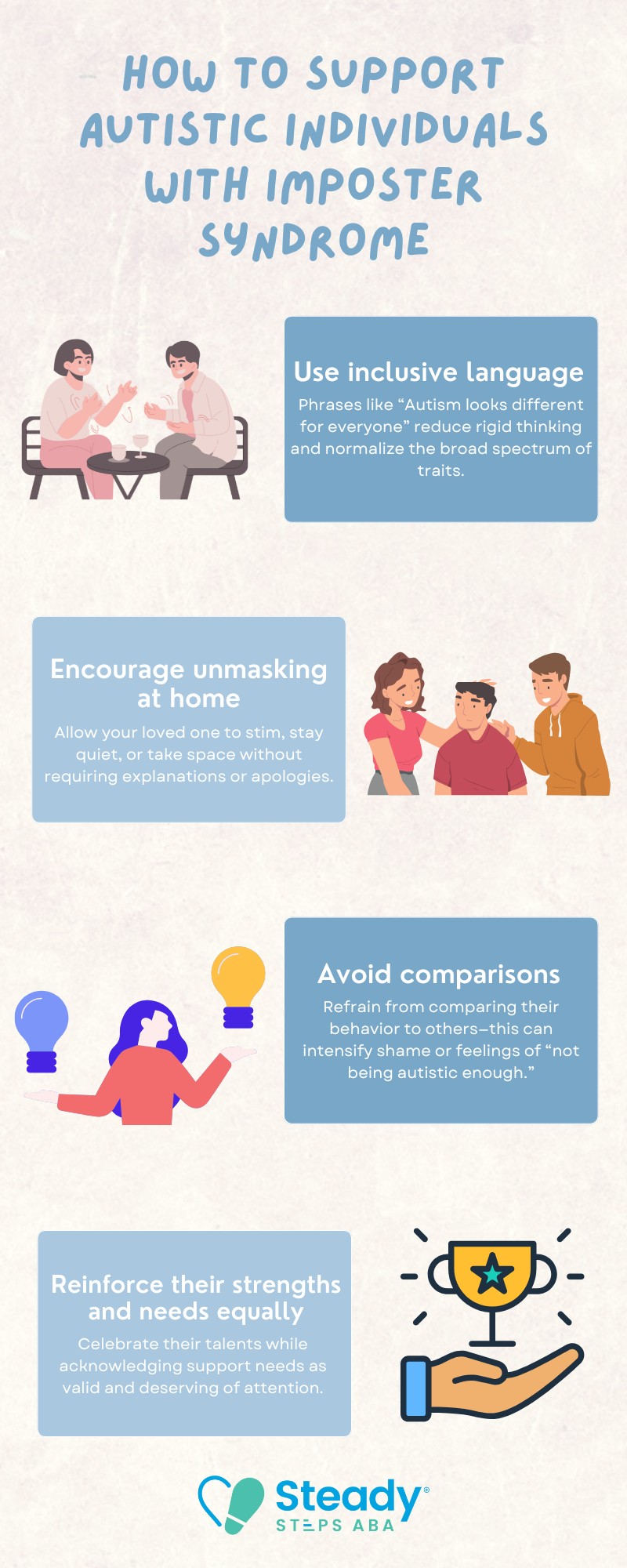Key Points:
- Imposter syndrome in autism can stem from masking, late diagnosis, or feeling “not autistic enough.”
- Many autistic individuals internalize self-doubt, even after receiving formal validation of their diagnosis.
- Emotional support and skill-building, such as through ABA therapy, can help reduce self-doubt and build confidence.
Many autistic individuals—especially those diagnosed later in life—wrestle with a persistent sense of self-doubt. Known as imposter syndrome in autism, this internalized feeling of being a “fraud” can cause people to question whether they really belong in the autistic community or if they’re simply overthinking. This isn’t just a fleeting insecurity—it can deeply affect identity, mental health, and access to support.
In this article, we’ll explore what imposter syndrome looks like in autistic people, why it happens, and how families, therapists, and autistic individuals themselves can manage it with compassion and practical tools.
What Is Imposter Syndrome in Autism?
Imposter syndrome in autism refers to feelings of self-doubt, disbelief, or inadequacy about one’s autism diagnosis, often paired with the belief that one is faking or exaggerating their traits. It commonly occurs in individuals who mask their symptoms or who have been diagnosed later in life.
This emotional struggle is not uncommon. Someone might receive an autism diagnosis but feel like they’re “not autistic enough” to deserve support. Or they may compare themselves to stereotypical depictions of autism and conclude that they must not be “really autistic.” Over time, this internal conflict can fuel anxiety, shame, and isolation.
Why Do Autistic People Experience Imposter Syndrome?
There are several unique factors that make autistic individuals more prone to imposter syndrome. Much of it comes from living in a society that misunderstands or narrowly defines what autism looks like. People who don’t fit the public image—especially those who speak fluently, make eye contact, or hold a job—are often dismissed or told they “don’t seem autistic.”
Because autism is a spectrum, every person experiences it differently. Unfortunately, those with less visible struggles may not feel “legitimately” autistic, even when their diagnosis is clinically accurate.
What Does Imposter Syndrome Look Like in Autistic Individuals?
Imposter syndrome doesn’t always look the same, but it tends to follow a set of emotional patterns. Some people express it outwardly, while others hold it in quietly for years. It can occur right after a diagnosis or even after years of knowing one is autistic.
Common signs include:
1. Doubting the Diagnosis
Many autistic individuals with imposter syndrome believe their diagnosis is a mistake or that they aren’t “autistic enough,” especially if they mask well or excel in certain areas.
2. Avoiding Community Spaces
They may steer clear of autism groups or services out of fear that they don’t truly belong or are taking resources from others with more visible needs.
3. Comparing to Other Autistics
Imposter syndrome can lead to harmful comparisons, feeling invalid because they don’t share identical traits or challenges with other diagnosed individuals.
4. Dismissing Their Struggles
Thoughts like “I’ve always had friends” or “I made it through school fine” can make them question their autism identity and minimize real challenges.
5. Guilt Around Accommodations
Even when accommodations are clearly needed, they may feel unworthy or guilty for asking, believing others have it worse or are more deserving.
6. Fear of Being Exposed
A lingering fear of being labeled as “faking it” can cause anxiety and discourage them from opening up about their autism or seeking support.
These thoughts can feed cycles of burnout and self-denial, especially in individuals who’ve spent years camouflaging their traits in work, school, or social settings.
How Does Late Diagnosis Contribute to Imposter Syndrome?
Late diagnosis can intensify impostor syndrome in autistic individuals by causing them to question the validity of their experiences. Without a lifelong framework for understanding their differences, they may struggle to accept their diagnosis and feel undeserving of support.
This internal conflict often stems from years of masking, mislabeling their struggles, or being praised for “passing” as neurotypical. When a diagnosis comes later in life, individuals may feel like they’re intruding on a space meant for “real” autistics or doubt whether their challenges were truly autism-related. This can lead to chronic self-doubt, emotional exhaustion, and reluctance to seek help.
How Can Masking Fuel Imposter Syndrome?
Masking can fuel imposter syndrome in autistic individuals by creating a disconnect between their inner struggles and outward appearance. When someone appears to cope well publicly but privately feels overwhelmed, they may question the legitimacy of their diagnosis.
Over time, masking becomes second nature—scripting conversations, hiding stims, or mirroring others to blend in. This can lead others (and the individual themselves) to overlook real sensory, emotional, or cognitive challenges. The more successful the masking, the more likely they are to feel like they’re “not autistic enough,” which reinforces feelings of fraudulence and deepens the cycle of burnout and self-doubt.

What Internal Tools Can Help Autistic Individuals Navigate Self-Doubt?
Empowering autistic individuals to develop their own coping strategies can build long-term resilience. These tools aren’t about “fixing” imposter syndrome overnight, but rather fostering self-understanding and pride.
Supportive tools include:
1. Journaling
Writing regularly about personal traits, emotional patterns, or validating moments can strengthen self-awareness and reinforce one’s identity as an autistic individual.
2. Connecting with autistic communities
Engaging with others who share lived experiences helps reduce isolation and builds confidence through shared language, humor, and insight.
3. Reframing self-talk
Replacing negative inner dialogue with affirming phrases like “I experience autism differently” promotes acceptance without needing outside approval.
4. Learning about neurodiversity
Studying the science and lived experiences behind neurodivergence helps challenge narrow stereotypes and affirms the spectrum’s vast diversity.
5. Setting personal boundaries
Avoiding invalidating spaces or people who dismiss one’s diagnosis protects emotional energy and reinforces a sense of control and self-worth.
Over time, the goal is to feel at peace with one’s identity, even when the world doesn’t always reflect it back.
How Can Parents and Caregivers Support Autistic Loved Ones?
If your child or adult family member is struggling with imposter syndrome in autism, your role can be pivotal. It’s important to validate their experience without reinforcing doubt. Focus on creating an environment where autistic traits are accepted, not questioned.
Helpful strategies include:

Imposter syndrome thrives in silence and shame. Open conversations and emotional safety can go a long way in breaking that cycle.
Can ABA Therapy Help with Imposter Syndrome in Autism?
Yes, ABA therapy can support autistic individuals experiencing imposter syndrome by addressing self-doubt, identity confusion, and emotional regulation. While not a cure for imposter syndrome, ABA strategies can help develop coping skills, increase self-advocacy, and reduce the impact of negative self-perception through individualized behavioral goals.
Many individuals with high-masking autism benefit from ABA approaches that validate their experience and provide structure for processing emotions. Therapists can use strengths-based techniques to reinforce confidence, challenge unhelpful beliefs, and promote authentic behavior, especially in safe environments where masking isn’t needed.
Support Through ABA Therapy in Maryland
Living with imposter syndrome in autism can feel isolating, but it doesn’t have to be. Whether the doubt stems from late diagnosis, years of masking, or external invalidation, support is possible, and healing is real. Building a positive self-view takes time, community, and the right tools.
Steady Steps ABA provides compassionate, person-centered ABA therapy in Maryland for children, teens, and adults with autism. Our programs are built to support emotional growth, self-advocacy, and confidence, without requiring anyone to mask who they are.
Contact us today to learn how our ABA therapy services in Maryland can help your loved one feel more secure, seen, and supported in their unique journey.






